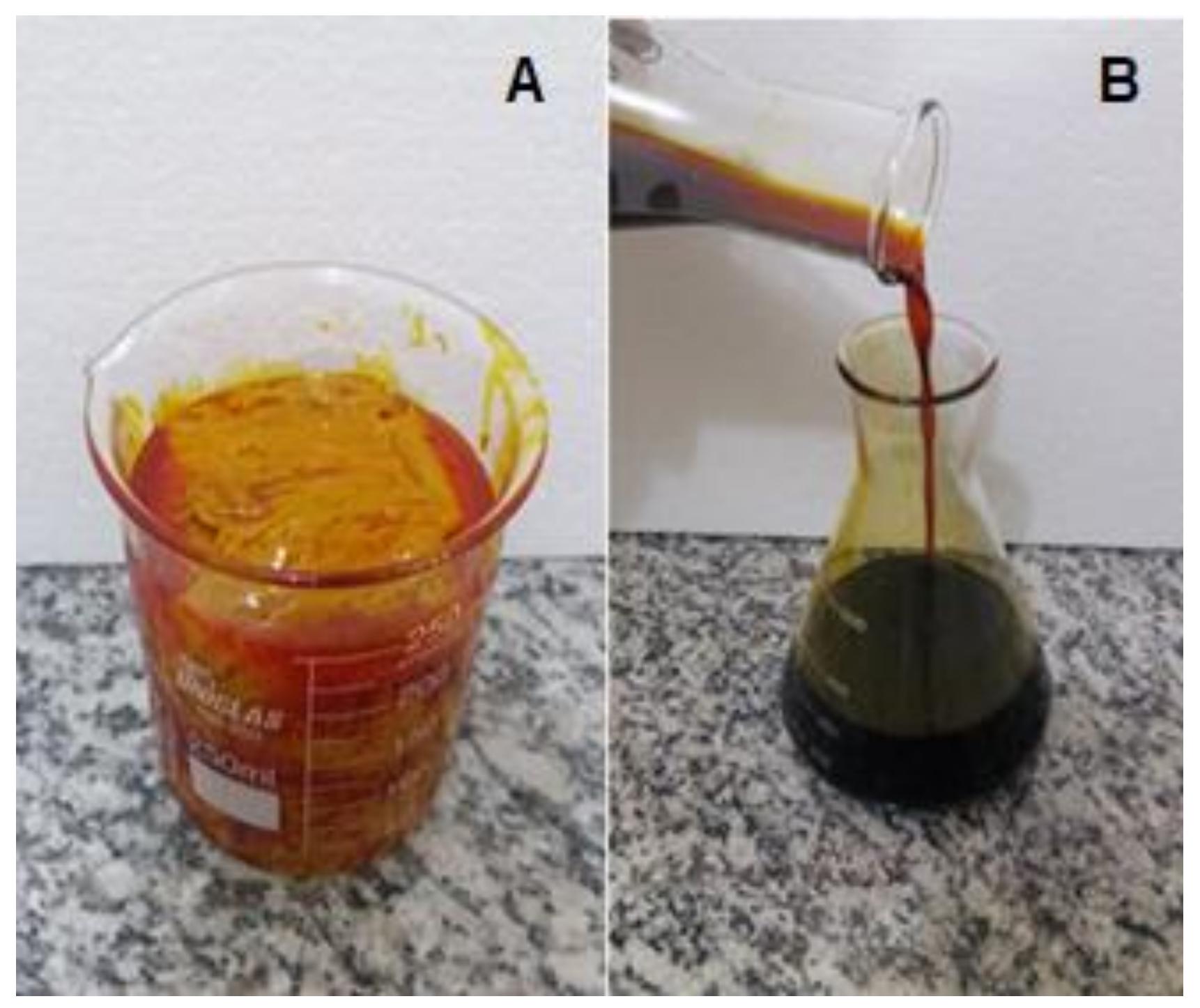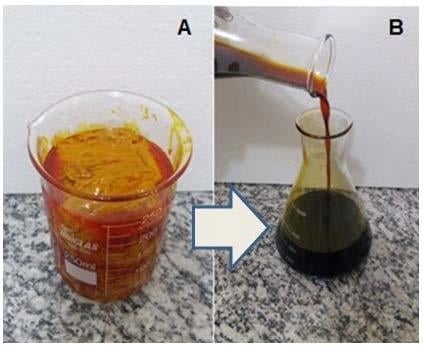High-Quality Biodiesel Production from Buriti (Mauritia flexuosa) Oil Soapstock
Abstract
1. Introduction
2. Results
2.1. Main Characteristics of Buriti Oil Soapstock
2.2. Acidulation of the Buriti Oil Soapstock
Effect of the Acid/Soapstock Molar Ratio and Effect of the Time on Soapstock Acidulation
2.3. Esterification of the Acid Oil
2.3.1. Effect of Methanol/Oil Molar Ratio on Esterification of Acid Oil
2.3.2. Effect of the Percentage of Catalyst on Esterification of Acid Oil
2.3.3. Effect of Time on Esterification of Acid Oil
2.4. Physical-Chemical Characterization of the Biodiesel Obtained from Buriti Oil Soapstock
3. Materials and Methods
3.1. Materials
3.2. Characterization of the Buriti Oil Soapstock
3.3. Acidulation of the Soapstock
3.4. Esterification of Acid Oil
3.5. Properties of Methyl Esters
4. Conclusions
Author Contributions
Funding
Acknowledgments
Conflicts of Interest
References
- Valente, O.S.; Pasa, V.M.D.; Belchior, C.R.P.; Sodré, J.R. Physical-chemical properties of waste cooking oil biodiesel and castor oil biodiesel blends. Fuel 2011, 90, 1700–1702. [Google Scholar] [CrossRef]
- Zhang, J.; Zhang, L.; Jia, L. Variables affecting biodiesel production from Zanthoxylum bungeanum seed oil with high free fatty acids. Ind. Eng. Chem. Res. 2011, 51, 3525–3530. [Google Scholar] [CrossRef]
- Phan, A.N.; Phan, T.M. Biodiesel production from waste cooking oils. Fuel 2008, 87, 3490–3496. [Google Scholar] [CrossRef]
- Marchetti, J.M. A summary of the available technologies for biodiesel production based on a comparison of different feedstock’s properties. Process Saf. Environ. Prot. 2012, 90, 157–163. [Google Scholar] [CrossRef]
- Santori, G.; Nicola, G.D.; Moglie, M.; Polonara, F. A review analyzing the industrial biodiesel production practice starting from vegetable oil refining. Appl. Energy 2012, 92, 109–132. [Google Scholar] [CrossRef]
- Rull, V.; Montoya, E. Mauritia flexuosa palm swamp communities: Natural or human-made? A palynological study of the Gran Sabana region (northern South America) within a neotropical context. Quat. Sci. Rev. 2014, 99, 17–33. [Google Scholar] [CrossRef]
- Cunha, M.A.E.; Neves, R.F.; Souza, J.N.S.; França, L.F.; Araujo, M.E.; Brunner, G.; Machado, N.T. Supercritical adsorption of buriti oil (Mauritia flexuosa Mart.) in γ-alumina: A methodology for the enriching of anti-oxidants. J. Supercrit. Fluids 2012, 66, 181–191. [Google Scholar] [CrossRef]
- Ribeiro, R.D.; Coelho, M.A.Z.; Barreto, D.W. Production of concentrated natural beta-carotene from buriti (Mauritia vinifera) oil by enzymatic hydrolysis. Food Bioprod. Process. 2012, 90, 141–147. [Google Scholar] [CrossRef]
- Aquino, J.S.; Pessoa, D.C.N.P.; Araújo, K.L.G.V.; Epaminondas, P.S.; Schuler, A.R.P.; Souza, A.G.; Stamford, T.L.M. Refining of buriti oil (Mauritia flexuosa) originated from the Brazilian Cerrado: Physicochemical, thermal-oxidative and nutritional implications. J. Braz. Chem. Soc. 2012, 23, 212–219. [Google Scholar] [CrossRef]
- Pardauil, J.J.R.; Souza, L.K.C.; Molfetta, F.A.; Zamian, J.R.; Rocha Filho, G.N.; Costa, C.E.F. Determination of the oxidative stability by DSC of vegetable oils from the Amazonian area. Bioresour. Technol. 2011, 102, 5873–5877. [Google Scholar] [CrossRef]
- Farhoosh, R.; Einafshar, S.; Sharayei, P. The effect of commercial refining steps on the rancidity measures of soybean and canola oils. Food Chem. 2009, 115, 933–938. [Google Scholar] [CrossRef]
- Su, E.; Wei, D. Improvement in biodiesel production from soapstock oil by one-stage lipase catalyzed methanolysis. Energy Convers. Manag. 2014, 88, 60–65. [Google Scholar] [CrossRef]
- Haas, M.J.; Bloomer, S.; Scott, K.M. Simple, high-efficiency synthesis of fatty acid methyl esters from soapstock. J. Am. Oil Chem. Soc. 2000, 77, 373–379. [Google Scholar] [CrossRef]
- Haas, M.J.; Michalski, P.J.; Runyon, S.; Nunez, A.; Scott, K.M. Production of fame from acid oil, a by-product of vegetable oil refining. J. Am. Oil Chem. Soc. 2003, 80, 97–102. [Google Scholar] [CrossRef]
- Piker, A.; Tabah, B.; Perkas, N.; Gedanken, A. A green and low-cost room temperature biodiesel production method from waste oil using egg shells as catalyst. Fuel 2016, 182, 34–41. [Google Scholar] [CrossRef]
- Mekala, M.; Goli, V.R. Kinetics of esterification of methanol and acetic acid with mineral homogeneous acid catalyst. Chin. J. Chem. Eng. 2015, 23, 100–105. [Google Scholar] [CrossRef]
- Soltani, S.; Rashid, U.; Al-Resayes, S.I.; Nehdi, I.A. Recent progress in synthesis and surface functionalization of mesoporous acidic heterogeneous catalysts for esterification of free fatty acid feedstocks: A review. Energy Convers. Manag. 2017, 141, 183–205. [Google Scholar] [CrossRef]
- Shuit, S.H.; Tan, S.H. Biodiesel production via esterification of palm fatty acid distillate using sulphonated multi-walled carbon nanotubes as a solid acid catalyst: Process study, catalyst reusability and kinetic study. BioEnergy Res. 2014, 8, 605–617. [Google Scholar] [CrossRef]
- Xie, W.; Zhao, L. Heterogeneous cao–moo3–sba-15 catalysts for biodiesel production from soybean oil. Energy Convers. Manag. 2014, 79, 34–42. [Google Scholar] [CrossRef]
- Agência Nacional do Petróleo, Gás Natural e Biocombustíveis. Available online: http://www.anp.gov.br/?pg=76798/ (accessed on 12 January 2018).
- Guo, F.; Xiu, Z.-L.; Liang, Z.-X. Synthesis of biodiesel from acidified soybean soapstock using a lignin-derived carbonaceous catalyst. Appl. Energy 2012, 98, 47–52. [Google Scholar] [CrossRef]
- Lôbo, I.P.; Ferreira, S.L.C.; Cruz, R.S. Da biodiesel: Parâmetros de qualidade e métodos analíticos. Quím. Nov. 2009, 32, 1596–1608. [Google Scholar] [CrossRef]
- Saloua, F.; Saber, C.; Hedi, Z. Methyl ester of [maclura pomifera (rafin.) schneider] seed oil: Biodiesel production and characterization. Bioresour. Technol. 2010, 101, 3091–3096. [Google Scholar] [CrossRef]
- Freitas, S.V.D.; Pratas, M.J.; Ceriani, R.; Lima, A.S.; Coutinho, J.A.P. Evaluation of predictive models for the viscosity of biodiesel. Energy Fuels 2011, 25, 352–358. [Google Scholar] [CrossRef]
- Sajjadi, B.; Raman, A.A.A.; Arandiyan, H. A comprehensive review on properties of edible and non-edible vegetable oil-based biodiesel: Composition, specifications and prediction models. Renew. Sustain. Energy Rev. 2016, 63, 62–92. [Google Scholar] [CrossRef]
- Kakati, J.; Gogoi, T.K.; Pakshirajan, K. Production of biodiesel from Amari (Amoora Wallichii King) tree seeds using optimum process parameters and its characterization. Energy Convers. Manag. 2017, 135, 281–290. [Google Scholar] [CrossRef]
- Patel, A.; Arora, N.; Mehtani, J.; Pruthi, V.; Pruthi, P.A. Assessment of fuel properties on the basis of fatty acid profiles of oleaginous yeast for potential biodiesel production. Renew. Sustain. Energy Rev. 2017, 77, 604–616. [Google Scholar] [CrossRef]
- Meher, L.C.; Sagar, D.V.; Naik, S.N. Technical aspects of biodiesel production by transesterification—A review. Renew. Sustain. Energy Rev. 2006, 10, 248–268. [Google Scholar] [CrossRef]
- Knothe, G. Dependence of biodiesel fuel properties on the structure of fatty acid alkylesters. Fuel Process. Technol. 2005, 86, 1059–1070. [Google Scholar] [CrossRef]
- Jain, S.; Sharma, M.P. Stability of biodiesel and its blends: A review. Renew. Sustain. Energy Rev. 2010, 14, 667–678. [Google Scholar] [CrossRef]
- Albuquerque, M.L.S.; Guedes, I.; Alcantara, P.; Moreira, S.G.C. Infrared absorption spectra of Buriti (Mauritia flexuosa L.) oil. Vib. Spectrosc. 2003, 33, 127–131. [Google Scholar] [CrossRef]
Sample Availability: Samples of the compounds are available from the authors. |



| Soapstock | Buriti Oil 1 | |
|---|---|---|
| Characteristics | ||
| Acid value (mg KOH/g oil) Moisture and volatiles (%) | 6.9 9.1 | |
| Components fatty acids (wt% of total oil) | ||
| Palmitic acid (C16:0) | 21.1 | 15.99 |
| Palmitoleic acid (C16:1) | 0.2 | |
| Stearic acid (C18:0) | 1.6 | 1.39 |
| Oleic acid (C18:1) | 71.4 | 77.06 |
| Linoleic acid (C18:2) | 2.4 | 1.58 |
| Linolenic acid (C18:3) | 3.2 | 1.12 |
| Others | 2.29 | |
| Average molecular weights of fatty acids | 276.5 |
| Molar Ratio of Acid/Soapstock a | 0.6 | 0.8 | 1.0 |
|---|---|---|---|
| Conversion (%) | 91.3 | 94.4 | 92.5 |
| Time (min) b | 30 | 60 | 90 |
| Conversion (%) | 90.2 | 94.4 | 91 |
| Properties (Units) | RANP 45/2014 | ASTMD 6751 ** | EN 14214 *** | B100 Buriti Soapstock |
|---|---|---|---|---|
| Specific mass at 20 °C (kg/m3) | 850–900 | - | - | 877.3 |
| Kinematic viscosity at 40 °C (mm2/s) | 3.0–6.0 | 1.9–6.0 | 3.5–5.0 | 5.22 |
| Flash point min. (°C) | 100 | 130 | 101 | 190 |
| Acidity index max. (mg KOH/g) | 0.5 | 0.5 | 0.5 | 0.04 |
| Corrosivity to copper max. | 1 | 3 | 1 | 1 |
| Cold filter plugging point max. (°C) | 19 | - | −20 | 3 |
| Ester content min. (% mass) | 96.5 | - | 96.5 | 96.6 |
| Oxidative stability min. (h) | 8 | 3 | 6 | 16.5 |
© 2018 by the authors. Licensee MDPI, Basel, Switzerland. This article is an open access article distributed under the terms and conditions of the Creative Commons Attribution (CC BY) license (http://creativecommons.org/licenses/by/4.0/).
Share and Cite
Pantoja, S.S.; Mescouto, V.A.d.; Costa, C.E.F.d.; Zamian, J.R.; Rocha Filho, G.N.d.; Nascimento, L.A.S.d. High-Quality Biodiesel Production from Buriti (Mauritia flexuosa) Oil Soapstock. Molecules 2019, 24, 94. https://doi.org/10.3390/molecules24010094
Pantoja SS, Mescouto VAd, Costa CEFd, Zamian JR, Rocha Filho GNd, Nascimento LASd. High-Quality Biodiesel Production from Buriti (Mauritia flexuosa) Oil Soapstock. Molecules. 2019; 24(1):94. https://doi.org/10.3390/molecules24010094
Chicago/Turabian StylePantoja, Samantha Siqueira, Vanessa Albuquerque de Mescouto, Carlos Emmerson Ferreira da Costa, José Roberto Zamian, Geraldo Narciso da Rocha Filho, and Luís Adriano Santos do Nascimento. 2019. "High-Quality Biodiesel Production from Buriti (Mauritia flexuosa) Oil Soapstock" Molecules 24, no. 1: 94. https://doi.org/10.3390/molecules24010094
APA StylePantoja, S. S., Mescouto, V. A. d., Costa, C. E. F. d., Zamian, J. R., Rocha Filho, G. N. d., & Nascimento, L. A. S. d. (2019). High-Quality Biodiesel Production from Buriti (Mauritia flexuosa) Oil Soapstock. Molecules, 24(1), 94. https://doi.org/10.3390/molecules24010094









